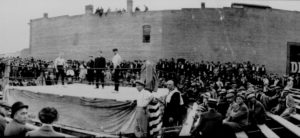Post written by Charlotte Conway, Public Programs Coordinator.
Daily Discovery: Investigating Clouds
NASA scientists study clouds to better understand and predict how Earth’s climate is changing. Community members can collect data about clouds and share it with scientists to help do this important research. In this activity, you will record cloud observations and learn how you can share data with researchers who collaborate with NASA!
Supplies:
- Pencil
- Book, clipboard, notebook, or other hard surface to write on
- Investigate Your Sky Today activity sheet, or a blank piece of paper
Instructions:
- Investigate the sky! If you are able to, go outside or observe the sky from a window.
- Notice and observe the shapes of the clouds you see. Are the clouds puffy with clear edges, thin and whipsy, or layered and sheet-like?
- Then draw a detailed sketch of what you see. The sky is big. To make an accurate observation, it is helpful to orient yourself north, divide the sky into quadrants, and sketch what you see in each one. If there are no clouds today, that’s okay! That is real data too, so make a note.
- Now, estimate the cloud coverage. How full is the sky today? Make an estimation how much the sky is covered with clouds from 0-100%.
- When you are finished sketching, go inside. Write down the date and time of day that you make your observations. Write down observations about the shape, size, color, and any features you noticed about the clouds next to your drawings. Try to use some of the scientific vocabulary below to classify the clouds you observed!
- If you enjoyed observing the clouds, join a community of participants working with NASA to collect important scientific data about clouds. Learn more and download an app to contribute your cloud observations: observer.glove.gov.
Want to download these directions? Click here for a handy PDF!
Follow along with our Daily Discovery! Click here for all activities that you can do at home.
Traducido por Károl de Rueda y Laura Vilaret-Tuma.
Descubrimiento en casa: Investigando las nubes
Los científicos de la NASA estudian las nubes para entender su función y también para predecir cómo está cambiando el clima. Pero, ¿sabías que tú también puedes colectar datos sobre ellas y compartirlos con los científicos? ¡Tus observaciones podrían resultar en investigaciones muy importantes! En esta actividad, vamos a observar a las nubes haciendo varias anotaciones mientras aprendemos cómo compartir estos datos ¡con los investigadores que colaboran con la NASA!
Artículos necesarios:
- Página de actividad incluida “¡Investiga el cielo de hoy!” o papel blanco
- Una superficie firme para escribir (como un libro, un portapapeles, o un cuaderno)
- Algo para escribir (lápiz, pluma o marcador)
Instrucciones:
- ¡Investiga el cielo! Si puedes, ve afuera, o también puedes observar el cielo desde una ventana.
- Presta atención a la forma de las nubes. ¿Son densas con bordes claros, delgadas y tenues, o tienen capas con áreas grises?
- Ahora dibuja detalladamente lo que ves. ¡El cielo parece ser infinito! Para formar una observación precisa, es útil orientarse hacia el norte, dividir el cielo en cuadrantes (o cuatro partes), y dibujar lo que observas en cada uno de ellos. Si no hay ninguna nube, ¡no te preocupes! Apúntalo de igual manera porque este dato también provee información importante.
- Estima su cobertura. ¿Qué tan lleno está el cielo de nubes? Haz un estimado desde 0-100%.
- Cuando termines de anotar tus datos, apunta la fecha y hora en las cuales hiciste tus observaciones. Al lado de tus dibujos, escribe sobre sus formas, tamaño, color y otras características que hayas notado. Puedes tratar de utilizar el vocabulario científico incluido abajo para clasificarlas.
- Si esta actividad te ha gustado, únete a la comunidad de participantes que trabajan con la NASA para recopilar datos científicos importantes sobre las nubes. Obtén más información y encuentra una aplicación para contribuir con tus observaciones en: observer.glove.gov.
¿Te gustaría descargar esta actividad? Haz clic aquí para obtener un archivo PDF.
Para encontrar actividades, ideas y mucho más descubrimiento en casa, ¡síguenos!


























